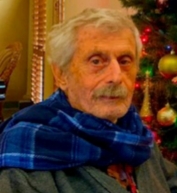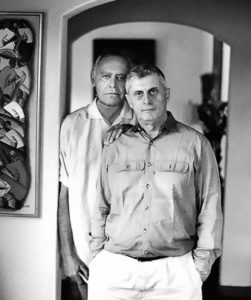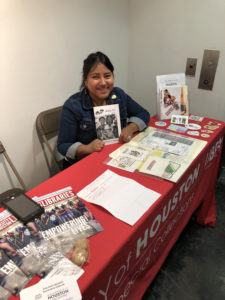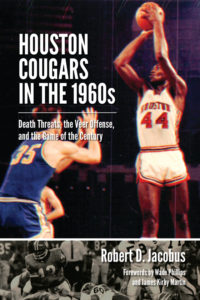
Nicholas John Tsacrios passed away in Sarasota, Florida on May 4, 2020 at the age of 92 from natural causes. Nick was the long-time companion of José Quintero, legendary Tony Award winning Broadway Director and Founder of Circle in the Square in Manhattan.
Nick was born on November 5, 1927 in Clearwater, Florida to Greek parents. His loving mother Sevasti Tsacrios passed away when Nick was only two years old. Nick was raised by his loving father John M. Tsacrios, Sr. who was a prominent pioneer merchant and civic leader in Clearwater, Florida.
Nick is survived by one brother Manuel “Buster” Tsacrios and a half-sister Maria John Tsacrios Molett and half-brothers John M. Tsacrios, Jr. and Frank John Tsacrios.
Nick was the eighth of nine children and the first to graduate from college due to the encouragement and support of his stepmother Xanthippi Tsacrios who he and José loved very much. Nick studied at the University of Florida and at the University of Madrid in Spain where he learned Spanish and became a bullfighter.
Nick was a creative adventurous person who loved cooking, entertaining, gardening, the arts, and caring for animals especially his loving cat Gato. He was renowned for his wonderful sense of humor that he got from his father.
Nick met José Quintero in the 1950’s in New York City when Nick was at the height of his career as an advertising executive in Manhattan. Nick and José had endearing friendships throughout their lives with renowned artists Liv Ullmann, Gloria Vanderbilt, Vanessa Redgrave, Tennessee Williams, Mexican star Dolores del Rio, Jason Robards, Roddy McDowall, Charles Nelson Reilly, dancer and choreographer Martha Graham, Greek film actor and artist Vassili Lambrinos, and Angelina Fiordellisi of the Cherry Lane Theater in New York City.
Nick was a significant source of support for José Quintero’s work as a lecturer and professor at the University of Houston, Florida State University, the Burt Reynolds Institute for Film and Theatre in Palm Beach, Florida, and during Quintero’s theater workshops in Los Angeles, California, and directing plays at Houston’s Alley Theater. Nick and José worked closely for many years with their beloved friend Sydney Berger, the revered former Director, Producer, and Mentor of the University of Houston School of Theatre & Dance.
Nick was instrumental in establishing the José Quintero Archives at the University of Houston which also houses the José Quintero Theater. Nick maintained a supportive relationship with the José Quintero Theater in New York City.
During Nick’s later years in Sarasota he was blessed to be surrounded by many loving, caring friends especially George Karabatsos from Saint Barbara’s Greek Orthodox Church where Nick loved to volunteer.
Memorial services were held at Holy Trinity Greek Orthodox Church in Dallas, Texas, Saint Barbara’s Greek Orthodox Church in Sarasota, Florida, and Nick’s beloved Saint Nicholas Cathedral in Tarpon Springs, Florida.
John M. Tsacrios, Jr. brother of Nicholas John Tsacrios, provided this memorial.
Due to the outbreak of COVID-19 (coronavirus), on-site access to Special Collections is unavailable. However, staff remain available to support teaching, learning, and research activities. We ask that researchers contact a collection curator or inquire here for assistance.
Karla A. Lira is a Ph.D. History student at the University of Houston. Lira’s research focuses on multi-racial dynamics of Latinos and Blacks in the space of Basketball during the 1960s. Her current project, “True We’ll Ever Be,” sheds light on the social relations Latinos and Blacks had in the city of Houston and the University of Houston Basketball Program through oral interviews. She was kind enough to share some of her research with us below.
“And to thy memory cherished, True we’ll ever be.”
HOUSTON, March 2019 — After the Spirit of Houston band finished the last stanza, first comes Galen Robinson Jr., then Armoni Brooks, followed by Corey Davis Jr., and the rest of the Men’s Basketball team to “The Cage,” the specially designated courtside student seating section, to high five all the student fans in a new cougar tradition. Black, Latino, Asian, all races celebrate together at the Fertitta Center as the University of Houston, one of the most diverse universities in the nation, celebrates another victory.
This freedom of celebration, race inclusion, and community was not always the case.
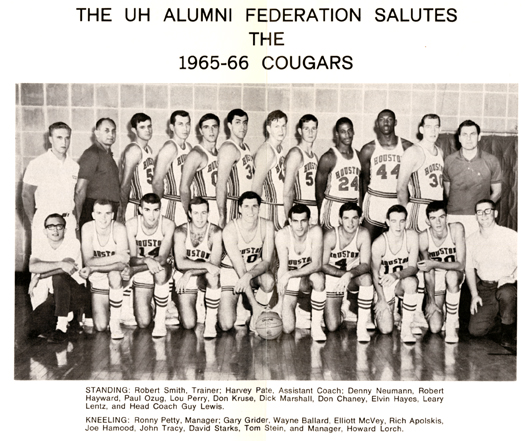
from the UH Alumni Federation Basketball Appreciation Dinner program (1966), Athletics Department Records
In 1962, the university integrated and signed the first African-Americans, Elvin Hayes and Don Chaney to play basketball. The social transition was eased by various people including Coach Guy V. Lewis, Harvey Pate, and student manager Howard Lorch. These individuals challenged the societal prejudice against the Black community. As Elvin “BIG E” Hayes recalled, student athletes such as Don Chaney, Warren McVea, and others helped create this integrated environment which everyone can enjoy.
Because of Houston’s unique history of desegregation and racial dynamics, I am researching Latinos in the basketball sphere. I am building my research on Katherine Lopez’s Cougars of Any Color: The Integration of University of Houston Athletics, 1964-1968, which emphasizes the many facets of racial integration at the university’s athletics program in the 1960s. I am also using The University of Houston Athletics Department Records in Special Collections where I have found pamphlets, donor records, and program guides that have uncovered race relations during the Civil Rights Era at University of Houston. My research breaks the Black and white racial dynamics by adding Latinos into the conversation.
The hardships of Hayes, Chaney, and McVea’s experience have set the pathway for diverse athletes to be here. This 2019 season is special. The UH Men’s Basketball Team won the regular season American Athletic conference championship, were the first to make it to the NCAA Sweet 16 since the Phi Slama Jama reign, were the first in the history of the institution to host ESPN’s College Game Day, and were one of the seven teams chosen by the NCAA to be part of their March Madness Confidential Series. The Cougars broke several records; Corey Davis Jr. has scored more than 1,000 points, making him the 48th player to accomplish this at the institution. The eccentric senior, Galen Robinson Jr. has triumphed in over 100 victories during his time in the Cougar uniform and is still counting.
With March Madness reaching its crescendo, it is important to give credit and acknowledge those that broke the racial barrier and made it possible for student athletes, coaches, staff, and students to come together and enjoy this communal winning moment. Go Coogs!
Special thanks to Elvin Hayes and Howard Lorch. Your kindness is felt.
Last month Lawndale Art Center hosted the 15th annual Zine Fest Houston festival. Held annually in Houston, Texas, Zine Fest Houston (ZFH) was founded in 2004 by local creative shane patrick boyle as an event dedicated to promoting zines, mini-comics, and other forms of small press, alternative, underground, DIY media and art. Following the donation of the ZFH records and zine collections to UH’s Special Collections and the in the wake of boyle’s unexpected passing in 2017, current ZFH organizers (Maria-Elisa Heg and Stacy Kirages) collaboratively worked with UH’s Hispanic Collections Archivist, Elizabeth Lisa Cruces to increase awareness of boyle’s contributions to Houston’s DIY community and local history. boyle was an avid collector and creator of zines and is responsible for the bulk of zines and ephemera found in the collection. Thanks to spb’s collecting and contributions to growing the DIY scene in Houston, ZFH and other creatives have been able to flourish.
In addition to showcasing some of the earliest hand-made artwork and ephemera from the ZFH Records, Cruces provided information to attendees on how to make their own zines and how to donate zines to the archives. Regarding the future of this living archive, Cruces said, “For the ZFH archives to succeed in their mission—to more inclusively preserve Houston’s diverse voices, in particular LGBTQ and minority groups, we not only need to ensure that the collection is accessible to all, but that it continues to grow and in turn show the increasingly national and transnational contributions of Houstonians.”
College basketball used to be a small game. A niche sport, once it was played on small courts, in small gymnasiums, in front of small crowds. Just over fifty years ago however, on January 20, 1968 in the Astrodome, the University of Houston (and the University of California, Los Angeles) forever altered the scale of the game in what has become known as the Game of the Century.
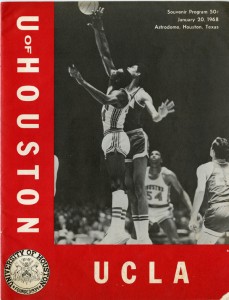
program from the Game of the Century (Athletics Department Records)
Regardless of the particulars, it was destined to be a historic match-up. While any given season might feature similar, high-profile, games between highly ranked teams, the 1968 regular season game between UCLA and Houston had a number of compelling story lines that intrigued even the casual sports fan. There was the blue blood, #1 team in the nation (the UCLA Bruins), riding a 47 game winning streak that spanned two and a half years and boasting three of the last four national championships under the tutelage of the legendary “Wizard of Westwood,” John Wooden. Their most recent in 1967 included a 73-58 defeat of the University of Houston Cougars in the Final Four. Anchored by the immeasurable talent of Lew Alcindor (later known as Kareem Abdul-Jabbar), the UCLA Bruins were a legitimate dynasty, ultimately claiming every national championship between 1967 and 1973. In the other corner, the up-and-coming “underdog” program, ranked #2 in the nation and riding their own winning streak (undefeated since their loss to UCLA the previous season), the University of Houston Cougars were coached by Guy V. Lewis, led on the court by the likes of Elvin Hayes, Ken Spain, and Don Chaney, and eager to prove just how good they were after last year’s setback.
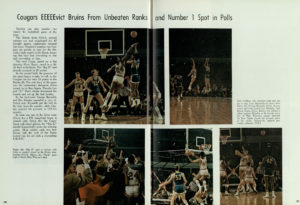
a full-color, two page spread from the 1968 Houstonian yearbook documents the Cougars’ victory
Given all of these particulars, how could the game be any bigger? Mix in a grand stage of national television coverage (a first for college basketball) and the surreal setting of the Eighth Wonder of the World.
The court for the contest was shipped in from Los Angeles, ironically enough, and assembled in the Astrodome on top of what should have been second base. It must have looked like a postage stamp to most of the 52,693 fans (a world-wide attendance record for any basketball game) packed into the dark corners of the Dome. Even more watched at home as this “small” game was played against a grand, cavernous backdrop.
TVS Television Network promoted the game and sold broadcasting rights to over 100 television stations across the country. Previously, there had only been efforts to televise games locally and in 1961 a “national” broadcast of the Ohio State / University of Cincinnati game in the NCAA finals was televised in just two cities–Columbus and Cincinnati, Ohio. The pros in the National Basketball Association had only begun the broadcast experiment in the 1950s and were still torn on whether or not they wanted to televise the league’s “good games,” for fear of losing ticket revenue at the turnstile. What was happening now in 1968 was not just novel, it was radical. And, it was successful in more ways than one. Houston defeated UCLA 71-69, ended the Bruins winning streak, and solidified their place in college basketball lore.
In Houston Cougars in the 1960s: Death Threats, the Veer Offense, and the Game of the Century by Robert Jacobus, Houston’s Elvin Hayes reflected back on the legacy of the game saying, “It just created euphoria and an atmosphere for college basketball that wasn’t there previously. I think that game kicked the door down, opened the windows, and knocked the roof off the house. What we have today in March Madness is what I think the game in 1968 opened.”
